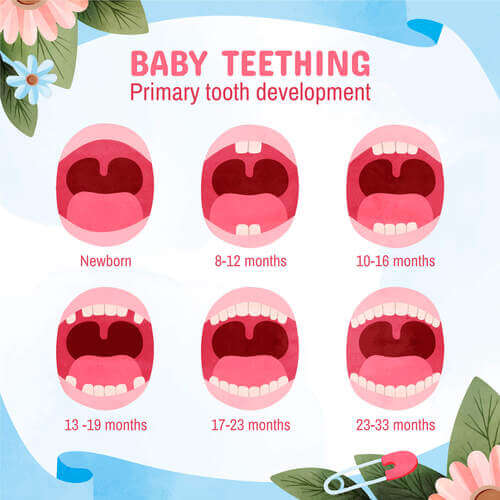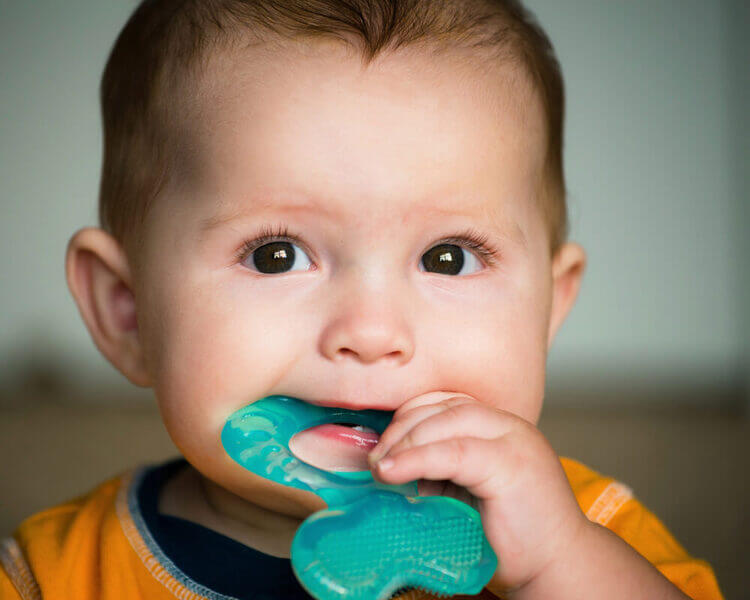Those adorable little gummy smiles that melt your heart can quickly turn into grizzles and tears when teething strikes. We can feel your desperation to find some tried and tested home remedies for teething baby at night. So, look no further! We understand your pain, and that of your baby’s.
As a parent, witnessing your baby’s discomfort can be tough, especially at night when sleep seems like a distant dream for both of you. But fear not! There are a number of safe and effective home remedies you can use to soothe your teething baby and get everyone back on track to a restful night’s sleep.
Understanding Teething: Why and How it Happens
Teething is a natural developmental stage where your baby’s first teeth erupt through their gums. This exciting milestone typically starts around 6 months of age. It paves the way for your baby to explore new textures and eventually transition to solid foods. But beneath those emerging pearly whites lies a hidden battleground!
Here’s the science behind the fussiness:
Tooth Development
Long before you see any signs, your baby’s teeth have been quietly forming beneath the gums since the embryonic stage. As these tiny teeth grow, they begin to press against the gum tissue, causing pressure and inflammation.
Breaking Through
The most noticeable discomfort comes when the teeth finally break through the gum surface. This process disrupts the gum tissue and can be quite uncomfortable for your baby.
While the exact reason for teething pain isn’t fully understood, the combination of pressure, inflammation, and disruption of the gums is likely the culprit behind the tears and crankiness.
When Do Babies Start Teething?
Babies typically start teething around 6 months of age, though it can vary from baby to baby. Some little ones might start as early as 3 months, while others wait until they’re closer to 9 months old.

Teething is a journey, and just like learning to walk or crawl, there’s a natural order to when those pearly whites emerge. Here’s a timeline to give you an idea of when to expect each tooth to make its grand appearance:
Early Erupters (Around 6-10 Months):
- Central incisors (bottom): These two little heroes at the front of the lower jaw are often the first to break through, paving the way for exploration and eventually, solid food adventures.
- Central incisors (top): Shortly after the bottom pair, the top two central incisors join the party, creating that adorable gummy grin we all love.
Middle of the Pack (Around 8-16 Months):
- Lateral incisors (both top and bottom): These guys flank the central incisors, filling in the gaps and giving your baby a more complete-looking smile.
The Backstage Crew (Around 12-24 Months):
- Canines (top and bottom): These pointy teeth, also known as eyeteeth, erupt next. They play a crucial role in tearing and ripping food as your baby transitions to more complex textures.
- First molars (both top and bottom): These larger molars grind and crush food, essential for efficient chewing as your baby expands their dietary repertoire.
The Grand Finale (Around 24-36 Months):
- Upper molars (second set): These molars complete the set of teeth in the upper jaw, allowing your toddler to tackle a wider variety of textures with ease.
- Lower molars (second set): Finally, the lower jaw welcomes its final set of molars, marking the completion of your baby’s primary dentition, with a total of 20 teeth!
Remember: This is just a general timeline, and every baby develops at their own pace. Some little ones might surprise you with an early eruption, while others might take their sweet time. Don’t worry if your baby’s teething journey doesn’t follow this exact schedule exactly. As long as their overall development is on track, there’s no need for concern.
Teething Symptoms
Teething is an important and exciting milestone in your baby’s development. So, what exactly is causing all the fuss?

As the first milk teeth push their way through the gums, there’s inflammation and pressure, which can be quite uncomfortable for your baby. This discomfort can manifest in a variety of ways, also known as “teething symptoms”, which we discuss below. While not every baby experiences all the symptoms, here’s a heads-up on what to expect during this exciting yet sometimes uncomfortable phase:
Redness and swelling
The most telltale sign of teething is inflammation and redness in the gums where the tooth is erupting. This area might also be a bit tender to the touch.
Drooling
Teething babies tend to drool excessively. This is partly due to the increased production of saliva as the body tries to soothe the irritated gums, and partly because they’re using their mouths to explore and find relief from the discomfort. As the saliva production goes into overdrive, it can lead to a constant stream of drool, leaving you with more bibs to change than usual.
Increased fussiness and crying
This is a telltale sign that something’s bothering your baby. Teething pain can disrupt your baby’s usual happy demeanor, making them fussier, irritable, and more prone to crying spells. This can be especially frustrating at night, leading to sleep disruptions for both of you.
Chewing and the need to gnaw
This is a natural instinct as your baby tries to find pressure and relief for their sore gums. They’ll chew on anything they can get their hands on, from teethers and toys to your fingers (watch out!)
Gum sensitivity
You might notice your baby is reluctant to feed or seems to be in pain when they put things in their mouth. This is due to the increased sensitivity in their gums.
Loss of appetite
The discomfort in their gums might make your baby less interested in feeding, especially if they’re nursing or eating solids that require more chewing.
Fever
A low-grade fever (around 100°F or 37.8°C) can sometimes accompany teething. However, if your baby’s fever is higher or persists for more than a few days, consult your pediatrician.
Cheek rubbing and ear pulling
The pressure and discomfort in the gums can sometimes radiate to other areas of the face, leading your baby to rub their cheeks or pull on their ears.
Mild rash around the mouth
The constant drooling can irritate the delicate skin around your baby’s mouth, causing a red, bumpy rash.
Changes in sleep patterns
The discomfort and pain can disrupt your baby’s usual sleep patterns, making them wake up more frequently at night.
Remember: The presence of some or all of these symptoms doesn’t necessarily guarantee teething is the culprit. If you’re unsure or concerned about any of your baby’s symptoms, it’s always best to consult your pediatrician for proper diagnosis and guidance.
Nighttime Teething Troubles: Why Sleep Gets Disrupted
Nighttime is especially challenging when your baby is teething. The pain and discomfort can easily disrupt their sleep cycle, leading to frequent waking and crying. This lack of sleep can be frustrating for both you and your baby, creating a vicious cycle of exhaustion and irritability.
There are a few reasons why nighttime teething can be particularly bothersome:
Increased sensitivity
When everything is quiet at night, your baby might be more aware of the discomfort in their gums.
Positional discomfort
Lying down can put more pressure on your baby’s gums, making the pain more noticeable.
Disrupted sleep routine
The pain can easily wake your baby from sleep, making it difficult for them to settle back down and get a good night’s rest.
Home Remedies for Teething Baby at Night

Now that we understand the why behind the nighttime woes, let’s delve into the good stuff – effective home remedies for teething baby at night to get everyone back to sleep!
1. The Power of Cool
- Chilled Teething Rings: Teething rings are a classic for a reason. Pop a safe, BPA-free teething ring in the fridge or freezer for a short while before offering it to your baby. The coolness numbs their sore gums and provides much-needed relief.
- Cool Washcloth: A simple yet effective solution! Wet a clean washcloth, wring it out, and chill it in the fridge or freezer for 30 minutes. Let your baby chew on the cool, damp cloth to soothe their aching gums. To help with nighttime teething trouble, have a few washcloths ready in the refrigerator to save you the time and effort at night.
2. Your Finger
If it’s your baby’s first tooth coming in, you can use this simple solution of letting your little one chew on your finger. No need to get up, go anywhere, or get anything. Just make sure your hands are clean before they get their gums on your finger.
3. Gentle Gum Massage
A gentle gum massage can be a calming and effective way to provide relief. Wash your finger thoroughly and gently rub your fingertip on your baby’s gums in a circular motion. The pressure can help ease the discomfort and provide a calming sensory experience.
4. Comforting Cuddles and Soothing Sounds
Sometimes, all your baby needs is your love and presence. Cuddle your baby close, rock them gently, and sing calming lullabies or play white noise. The warmth of your touch and the soothing sounds can be very comforting for your little one.
5. Age-Appropriate Chewing Options (For Babies 6 Months and Older)
If your baby is 6 months old or older and has started eating solids, you can offer them some safe and age-appropriate chewing options:
- Mesh Teethers with Frozen Purees: Fill a mesh feeder with chilled purees like applesauce, bananas, or yogurt. The coolness and texture can provide relief for your baby’s gums while also offering a taste sensation. Remember to supervise your baby closely while they use the mesh feeder and discard any uneaten puree after use.
- Chilled Fruits and Vegetables: Once your baby is comfortable with solids, offer them chilled fruits and vegetables like peeled and sliced cucumber, pear, or mango. The coolness will numb their gums, and the soft texture is safe for them to gnaw on. Opt for fruits and vegetables that are naturally cold or can be easily chilled in the refrigerator.
6. Pain Relief Medications (Use with Caution)
If the above home remedies don’t seem to be enough, you can consider using pain relief medications like acetaminophen or ibuprofen. However, it’s crucial to consult your pediatrician before administering any medication to your baby. They can advise you on the appropriate dosage based on your baby’s weight and age, and ensure there are no underlying conditions that might require alternative treatment.
Safety Tips – Using Home Remedies for Teething Baby at Night
While the above suggested home remedies for teething baby at night are generally safe, it’s important to follow these safety tips:
Always supervise your baby
Never leave your baby unattended with a teething ring, washcloth, or any other chewable object.
Inspect teethers regularly
Check teething rings for any cracks or tears that could pose a choking hazard. Discard any damaged teethers immediately.
Beware of frozen objects
Don’t give your baby frozen teething objects directly. The extreme cold can damage their delicate gums.
Mesh feeder safety
Make sure the mesh feeder is age-appropriate and discard any uneaten purees to prevent spoilage and potential bacterial growth.
No amber teething necklaces
The American Academy of Pediatrics (AAP) advises against using amber teething necklaces due to strangulation and choking hazards.
Creating a Calming Bedtime Routine for Teething Babies
Establishing a consistent and calming bedtime routine can significantly improve your baby’s sleep, even during teething times. Here are some tips:
Warm bath
A warm bath before bedtime can be very relaxing for your baby. The warm water can be soothing and help them feel sleepy.
Gentle massage
After the bath, give your baby a gentle massage using calming baby oil. This can help them unwind and prepare for sleep.
Dim the lights
Dim the lights in your baby’s nursery about 30 minutes before bedtime to signal that it’s time to wind down.
White noise
White noise machines can create a calming and familiar sound that can mask any discomfort your baby might be feeling and help them fall asleep easier.
Stick to the routine
Consistency is key! Try to maintain a consistent bedtime routine every night, even on weekends, to help your baby establish a predictable sleep pattern.
Remember: Teething is a temporary phase, and your little one will eventually get through it. By incorporating these home remedies and creating a calming bedtime routine, you can help soothe your baby’s discomfort and get everyone back on track to a good night’s sleep.
Additional Tips and Considerations
Chamomile
Some parents swear by chamomile tea for its calming properties. However, there’s limited scientific evidence to support its effectiveness for teething pain. Consult your pediatrician before giving your baby any herbal remedies.
Teething tablets
Teething tablets containing ingredients like belladonna are not recommended due to potential safety concerns. Opt for safer alternatives like acetaminophen or ibuprofen if needed, always under the guidance of your pediatrician.
When to see a doctor
If your baby’s teething symptoms seem severe, such as a high fever, persistent diarrhea, or difficulty breathing, consult your pediatrician to rule out any underlying issues.
Beyond Teething: Maintaining Healthy Oral Hygiene

Even though teething is a temporary phase, it’s never too early to start thinking about your baby’s oral hygiene. Here are some tips:
Fingertip cleaning
Even before teeth erupt, you can gently wipe your baby’s gums with a clean, damp washcloth after each feeding. This helps remove bacteria and promotes good oral hygiene habits.
Teething brush
Once your baby has their first tooth, you can use a soft-bristled silicone finger brush to gently clean their teeth and gums. Brush twice a day, paying attention to the areas where the teeth meet the gums.
Fluoride toothpaste
When your baby is around 1 year old, and after consulting with your pediatrician, you can start using a pea-sized amount of fluoride toothpaste specifically designed for infants. Remember, supervise your baby during brushing to ensure they don’t swallow the toothpaste.
Final Words – How to Soothe a Teething Baby at Night
Teething can be a challenging time for both you and your baby. However, by understanding the causes of discomfort and utilizing these safe and effective home remedies for teething baby at night, creating a calming bedtime routine, and establishing healthy oral hygiene habits, you can help your baby navigate the teething phase with more comfort and ease.
Don’t forget to be patient, consistent, and most importantly, shower your baby with love and cuddles. This will help create a more comfortable and restful environment for your little one. Remember, this too shall pass, and soon your little one will be flashing a dazzling smile with all their pearly whites. So, hang tight, and they’ll be back to their usual happy self in no time!

